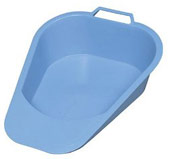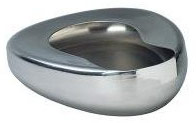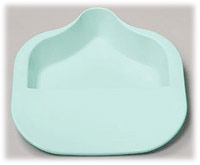A bed pan is a toiletry device in which people who are bedridden can use it to go to the bathroom. Bed pans are used when it is difficult for a person to get out of bed and go to the restroom due to disabilities, diseases, incontinence, severe injuries, or old age.
While usually utilized in health facilities, bed pans can also be used in a home environment. Bed pans can offer relief for bedridden patients because it is difficult for them to walk to the bathroom and bend the hips to sit on a toilet. Also, in most cases, it is hard for severely ill patients to resist going to the bathroom in their bed because walking to a restroom takes time and effort.
 There are many different kinds of bedpans; some are gender specific, while others are disposable or can be used continually after a good cleaning. Bed pans can be made from metal or hard plastic, and in recent years bed pans specific to a person’s ability to move his/her hips have come out. For instance, fracture bed pans are wedge shaped and allow caregivers to slide them under patients without having to move them, thus eliminating discomfort or pain. Bariatric bed pans are also made for comfort. Many obese patients complain that metal bed pans are cold and uncomfortable, but bariatric bed pans are made out of plastic and designed to hold two times the amount of defecation and fecal matter than a normal bed pan.
There are many different kinds of bedpans; some are gender specific, while others are disposable or can be used continually after a good cleaning. Bed pans can be made from metal or hard plastic, and in recent years bed pans specific to a person’s ability to move his/her hips have come out. For instance, fracture bed pans are wedge shaped and allow caregivers to slide them under patients without having to move them, thus eliminating discomfort or pain. Bariatric bed pans are also made for comfort. Many obese patients complain that metal bed pans are cold and uncomfortable, but bariatric bed pans are made out of plastic and designed to hold two times the amount of defecation and fecal matter than a normal bed pan.
 Buying Bed Pans
Buying Bed Pans
Purchasing and taking care of bed pans vary depending on what kind of bed pan you have. Disposable or plastic bed pans are cheaper, ranging from $10-$30 because they do not last as long and plastic requires more cleaning. Metal bed pans are more expensive and range from $40-$100.
- Bariatric Bed Pans – Supports weights up to 325lbs.
- Fracture Bed Pans – This bed pan is designed for immobile and fracture patients.
- Steel Saddle Bed Pans – Common steel bed pans found in hospitals.
 Plastic Saddle Bed Pans – These bed pans are made of a strong durable plastic that can withstand weight after many uses.
Plastic Saddle Bed Pans – These bed pans are made of a strong durable plastic that can withstand weight after many uses.
Maintaining a bed pan typically requires the caregiver to empty the fecal matter into a toilet and then cleaning the pan with soap and water with a rag. Afterwards, a strong disinfectant is used to effectively kill remaining bacteria.
 If you need bed pans that have to be sterilized in an autoclave, be sure to buy autoclavable bed pans. Get measuring indicators on the bed pan, if you need to measure the amount of urine or fecal matter in cc’s or ounces.
If you need bed pans that have to be sterilized in an autoclave, be sure to buy autoclavable bed pans. Get measuring indicators on the bed pan, if you need to measure the amount of urine or fecal matter in cc’s or ounces.
When using a bed pan, be sure to heat the pan to the person’s desired temperature. Simply place the bed pan in some warm water, then dry it.
If the person is able to move themselves to the side, be sure there are safety bed rails for them to grab onto for support.
Have plenty of bed cloths and towels available to dry and for use in case of spills.
